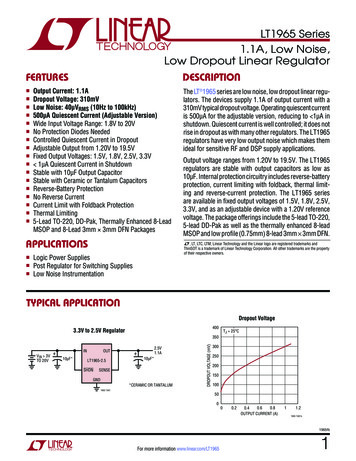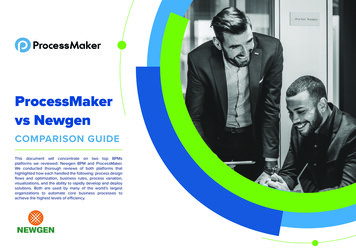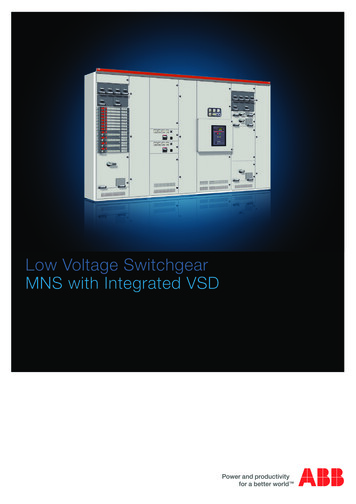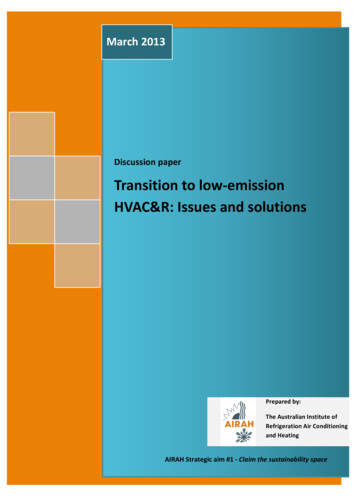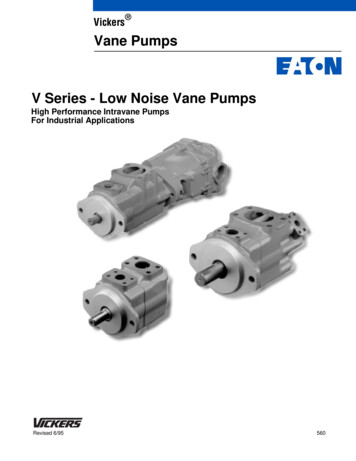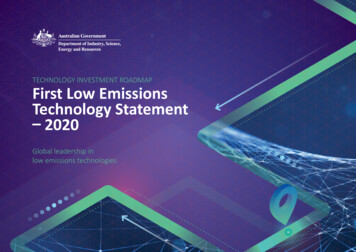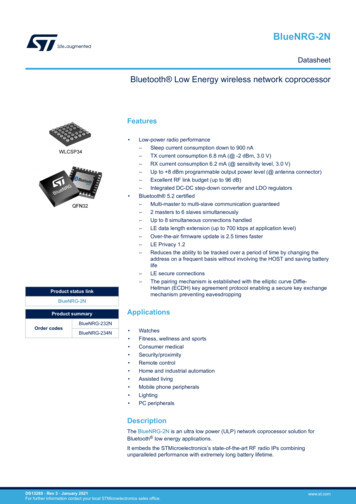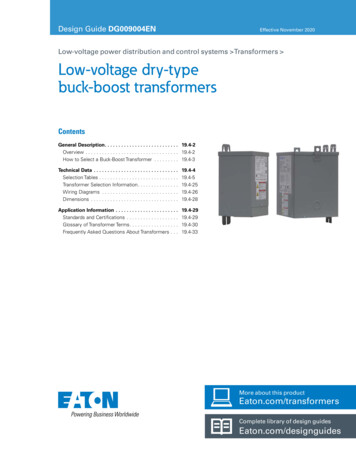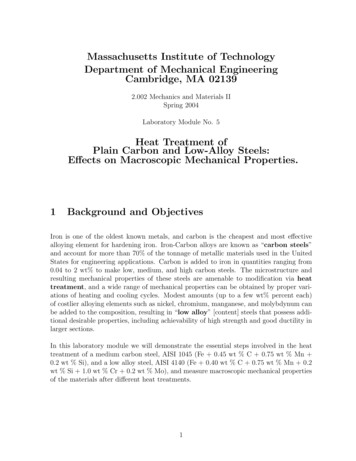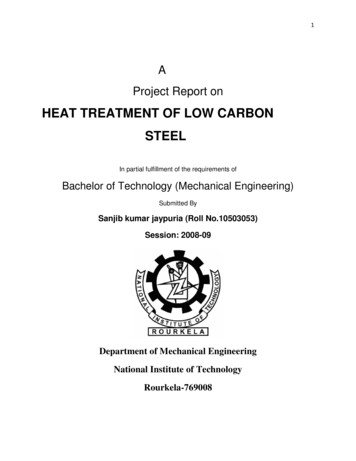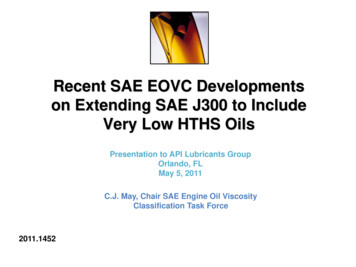
Transcription
Recent SAE EOVC Developmentson Extending SAE J300 to IncludeVery Low HTHS OilsPresentation to API Lubricants GroupOrlando, FLMay 5, 2011C.J. May, Chair SAE Engine Oil ViscosityClassification Task Force2011.1452
Topics Introduction/Background Progress to date including potential implications for APIspecifications Next Steps2
Reminder: What SAE J300 Is and Is NotIs: a Global Industry classification for engine oilsbased on fresh oil viscosity (at high and lowtemperatures and shear rates relevant to engineoperating regimes)Is Not: a specification with sheared viscosity, volatility,other bench test or engine performancerequirements3
Current SAE J300 (High Temp Specs W-4015W/20W/25W-40 & 405060KV100min., 00max., mm2/sec------------ 9.3 12.5 16.3 16.3 21.9 26.1HTHS 150min, mPa·s------------2.62.93.53.73.73.7Notes KV100 ranges a translation from SUS limits for 20, 30, 40, 50 grades (SAE J300circa 1950), themselves set arbitrarily HTHS limits are the result of extensive discussion, negotiation and comparisonwith OEM specs and commercial practice Currently, the lowest allowable HTHS viscosity is 2.6 mPa-s (20 grade)4
New SAE J300 Classifications At a 2005 SAE Open Forum on the future of SAE J300, Andy Jackson (EOVCChair) reviewed the classification system and suggested a number of ways thatit might be overhauled to offer a more rational basis for viscosity ranges–His presentation also anticipated future need for oils with HTHS values below 2.6 cP, as enginedesigners seek to improve fuel economy–A radical overhaul of J300 has traditionally been considered very difficult because it is soentrenched in specifications and consumer ‘understanding’In August 2009, an EOVC working group was formed with the mandate ofassessing the options for extending SAE J300 viscosity grades to oils with HTHS(150 C) viscosities below 2.6 cP.–At that time, one OEM branded oil was being marketed in Japan as a ‘0W10’ grade and atleast 2 OEM’s had expressed interest in revising SAE J300 to include lower HTHS oils–Driving force is continued quest for improved fuel economySince that time, multiple telecons and face-to-face meetings have been held totry to develop a consensus approach–EOVC has also interfaced with ASTM Subcommittee 7 which has responsibility for the HTHSmethods themselves5
EOVC and Working Group Activities EOVC WG participants have developed HTHS/KV100 data on approximately 150blends spanning the range of interest–Variety of technologies included in the blend studies (by no means comprehensive of alltechnologies)–Data also compared to historical studies quoted in SAE and ASTM reference papers–Much of this work is summarized in SAE Paper 2010-01-2286A strawman proposal developed by the Working Group was forwarded by EOVCin November, 2009 to ILSAC and ACEA for comment–Strawman based upon new 5 Grade (1.7 cP min HTHS), 10 Grade (2.0 cP min), and 15 Grade(2.3 cP min) with the same KV100 range as current SAE 20 (5.6 to 9.3 cSt)–Significant feedback provided to us by respondents6
EOVC and Working Group Activities (Cont’d) In July/Aug 2010 following further work/discussion, an exit ballot was issued toEOVC members and guests with 3 options for consideration1) Add 2 new grades, SAE 10 and 15 with 2.0 and 2.3 cP min HTHS, KV100 5.6 - 9.3 cSt2) Add 3 new grades, SAE 5, 10, 15 with 1.7, 2.0, 2.3 cP min HTHS, KV100 (5 grade) 4.1 - 9.3 cSt;KV100 (10, 15) as above3) Add 3 new grades, SAE 5, 10, 15 with 1.7, 2.0, 2.3 cP min HTHS, separate and distinct KV100ranges for each grade Lots of feedback received indicating that more work/discussion was necessary aswell as better definition of need from the OEM community As a result, EOVC sent a letter to ILSAC in November, 2010 requesting guidance onfundamentals such as how many new grades, viscosity ranges, nomenclature forthe new grades and timing for introduction–Feedback was discussed at December, 2010 EOVC meeting along with additional individual OEMconcerns raised during the meeting–It was clear that more internal OEM debate (ILSAC, JAMA, etc) was necessary to get more input–Japan disaster delayed a March, 2011 JAMA meeting which was to discuss this topic7
Summary of Current Project Status Some respondents have advised caution in making any changes to J300 untilneeds and implications were better defined Others point out that there are already low vis products in the marketplaceclaiming ‘SAE xW10) and there is some urgency for SAE definition of these newgrades to allow From previous exit ballots, discussions and presentations there are clearly twovery different groups of proponents as defined by these extremes:a. Add a full slate of viscosity grades below SAE 20 (down to 1.4 mPa-s)b. Add only one or perhaps two new grades below SAE 20; as future needs are better defined,J300 can be revised to add additional viscosity grades It appears to be clear that any new viscosity grades should have distinctkinematic viscosity ranges as well as HTHS limits; this would also affect SAE 20grade definitions The majority of respondents appear comfortable with HTHS increments of 0.3mPa-s for each new grade Getting the nomenclature part of the definition right is critical e.g. using SAE‘5’, ’10’, ’15’ has the potential for consumer confusion and misapplication8
What Might a Modified J300 Look Like? Unique kinematic viscosity ranges which split the current SAE 20 range (5.6to 9.3 cSt) This would have implications for shear stability specifications on wX-20grades New grades would also have repercussions for VGRA rulesExampleOnly forDiscussionPurposesSAEGradeKV MincStKV MaxcStHTHS Min20x 9.32.6“LVA”y x2.3“LVB”z y2.0“LVC”w z1.7etcetcetcetc9
Next Steps Waiting for further OEM input on needs and recommendations JAMA discussion to have occurred in late April awaiting feedback ILSAC may also discuss further Based upon feedback received will continue to fine-tune a proposal orproposals for consideration by EOVC membership Next EOVC meeting will be at June ASTM (done to provide sufficient time forJAMA/ILSAC/individual OEM discussion and feedback) Potential for a further exit ballot before any official TC-1 ballot is issued,depending upon support within the task force Need to work nomenclature issues in parallel Keep in mind that SAE J300 changes become mandatory 12 months after theformal publication of the revision10
05.05.2011 · assessing the options for extending SAE J300 viscosity grades to oils with HTHS (150 C) viscosities below 2.6 cP. – At that time, one OEM branded oil was being marketed in Japan as a ‘0W10’ grade and at least 2 OEM’s had expressed interest in revising SAE J300 to include lower HTHS oils – Driving force is continued quest for improved fuel economy Since that time, multiple .
